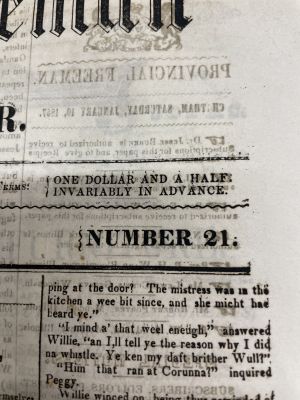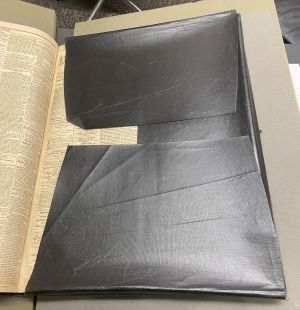The Provincial Freeman and weekly advertiser: Difference between revisions
No edit summary |
No edit summary |
||
| Line 14: | Line 14: | ||
==William Still== | ==William Still== | ||
Mr. William Still, a Black abolitionist who lived in Philadelphia, was a sporadic contributor to the newspaper and was responsible for distributing the newspapers to subscribers in Philadelphia. | Mr. William Still, a Black abolitionist who lived in Philadelphia, was a sporadic contributor to the newspaper and was responsible for distributing the newspapers to subscribers in Philadelphia. (cite1) It seems that Still was an avid reader of the newspapers because his copies are extremely worn down, as the pages have a yellowish tint with stains throughout. Also, there are sections of pages that have been cut out, which was probably because Still found these sections significant and necessary to keep, possibly in a scrapbook. | ||
Revision as of 21:03, 4 May 2022
Overview
The Provincial Freeman and weekly advertiser, is a collection of weekly newspapers from 1854-1857 published by Mary Ann Shadd Clad. The newspapers were written by different Black people, published in Canada, and preach freedom and equality for Black people in North America. The largest collection of the newspapers belong to the University of Pennsylvania.
How They Got to The University of Pennsylvania
The University of Pennsylvania has the most issues of The Provincial Freeman and weekly advertiser. There are not many owners of the original copies of the newspaper, which were normally two pages, front and back, with seven columns per page. The collection of newspapers was gathered by Mr. William Still. He most likely received his copies of the newspapers via the mail, as he lived in Philadelphia. His collection was given to the University of Pennsylvania in 1914 by F.E. Still, one of William Still’s relatives [1].
The Pages of the Newspapers
The newspapers are made out of super large, flimsy, and fragile paper so it would have been hard to preserve the newspapers over a long period of time. This explains why the newspapers are not in great condition. Between being shipped to the United States from Canada and being printed close to two centuries ago, it is clear why many of the pages are ripped and worn down. Newspapers in the 19th century were commonly printed very large because it was less expensive to print larger pages that could also include many advertisements. Every page in the newspaper is filled with advertisements, which helped fund the newspapers for around three years. Also, subscribers paid “one dollar and a half” in advance to receive the newspaper, which also helped fund it.

After They Got to the University of Pennsylvania
After the newspaper's arrival at Penn, they were rebound into a book sometime during the 20th century. Rebounding the newspapers into a book makes it much easier to keep the newspaper together and in good condition. The cover of the book is constructed of black Buckram cloth and is roughly 22 x 16.5 inches, making the book very heavy. While the back cover has huge black flaps that are used to maintain and cover the edges of the book.

William Still
Mr. William Still, a Black abolitionist who lived in Philadelphia, was a sporadic contributor to the newspaper and was responsible for distributing the newspapers to subscribers in Philadelphia. (cite1) It seems that Still was an avid reader of the newspapers because his copies are extremely worn down, as the pages have a yellowish tint with stains throughout. Also, there are sections of pages that have been cut out, which was probably because Still found these sections significant and necessary to keep, possibly in a scrapbook.
- ↑ Murray, Alexander L. “The Provincial Freeman: A New Source for the History of the Negro in Canada and the United States.” The Journal of Negro History, vol. 44, no. 2, 1959, pp. 123–35, https://doi.org/10.2307/2716034.